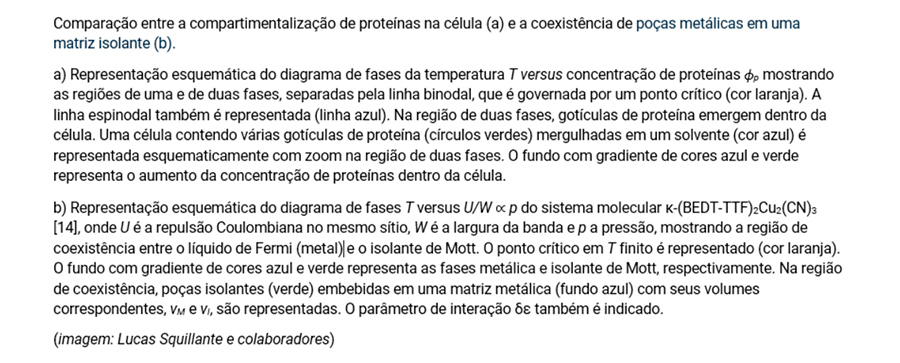Text: José Tadeo Arantes | FAPESP Agency
In physics, a two-component system can be modeled using classical mixture theory, which takes into account the corresponding fraction of each component and the interaction between them. Examples include the coexistence of high- and low-density phases in supercooled water and the coexistence of mineral aggregates in an insulating matrix in the so-called metal-insulator-Mott transition (See the graphical representation and detailed explanation in the first figure below).
Motivated by these kinds of considerations, researchers from the Universidad Estadual Paulista (Unesp) in Río Claro used concepts from condensed matter physics to describe the compartmentalization of proteins inside cells and proposed a Griffith-type cellular phase by analogy to the fundamental magnetic phase by Griffith. The study is coordinated by the professor Mariano de Souza Its first author was postdoctoral student Lucas Squillanti published In the magazine Asparagus.
“In the magnetic Griffith phase, magnetized or unmagnetized regions appear, respectively, in magnetized or ferromagnetic arrays, leading to a significant reduction in the dynamics of the systems. These 'rare regions' appear randomly. In previous work, we explored the so-called Griffith phase Electronic at the metal-insulator transition limit in Mott “In the current study, we consider protein droplets that form inside cells as ‘rare zones’ in direct analogy to the magnetic Griffith phase,” says Souza (Read more on: agencia.fapesp.br/34951).
The researcher states that the production of proteins inside the cell can reach a threshold concentration that leads to the separation of the liquid phase from the liquid, which leads to the fragmentation of proteins into droplets.
“Using thermodynamic tools, such as the Grüneisen coefficient, the Flory-Huggins model and the Avramov-Casalini model, we have demonstrated that, near the bilinear defining the phase separation, and also to the equivalent concentration between protein and solvent, the cellular dynamics decreases dramatically, giving rise to a cellular phase Griffith type.See the graphical representation in the second figure below).
The study also suggests that the Griffith-type cell phase is related to the origin of life and primitive organisms, according to the classic hypothesis presented by the Russian biologist and biochemist Alexander Oparin (1894-1980) in the 1930s, where only conjugates (small droplets composed of organic molecules aggregated in aqueous solution) with slow dynamics that were able to survive and develop.
“This in turn may be related to the fundamental role that homosexuality plays in the process of the evolution of life,” Souza says. It is worth noting that eccentricity is a property of an object or molecule that cannot be superimposed with its mirror image, as happens with human hands. Homogeneity is the dominance of individual asymmetries in the molecules of a biological system.
The researchers explain that increased protein diffusion time, in conjunction with decreased random fluctuations in the cell, plays an essential role in improving gene expression. The current study provides an alternative approach to studying protein fragmentation dynamics, which could also be applicable in other biological systems.
“It has been widely discussed in the literature that liquid-liquid phase separation plays an essential role in the development and treatment of diseases, more specifically in relation to tumorigenesis. The idea is that proteins encoded by genes associated with such diseases can be cleaved, affecting their role in mutations.” Cellular. Marcus MinicucciProfessor of General Medical Practice at Unesp University Botucatu Campus and co-author of the work.
Other examples of the role played by phase separation include cataracts (with retinal phase separation potentially causing visual impairment), neurodegenerative diseases, and even the SARS-CoV-2 virus (with catabolism of SARS2-NP proteins potentially leading to Inhibition of the immune response). Antivirus). Recently, it has been reported that phase separation of iron-binding repressor protein-1 could be used as an effective anti-cancer therapy.
“Liquid-liquid phase separation affects each disease differently and the formation of protein droplets can be beneficial or not. The Griffith-type cell phase we propose could have an important impact on the management and even treatment of diseases,” explains Minicucci. The study by Souza’s group explains The importance of the interdisciplinary nature of basic studies.
In addition to Squillante, Minicucci and Souza, researchers participated in the study Antonio Ceredonio (Unknown as Solterra), Roberto Lagos-Monaco (Unisp de Río Claro), Anikan Magnus Okpong (University of KwaZulu-Natal, Pietermaritzburg, South Africa), Luciano Rico (University of Iceland), and doctoral student Isis Melo, Souza's advisor.
The work received support from FAPESP through two projects (11/22050-4 and 18/09413-0).
The article Griffith-like cellular stage Can be reached at: www.sciencedirect.com/science/article/pii/S2405844024106536.






